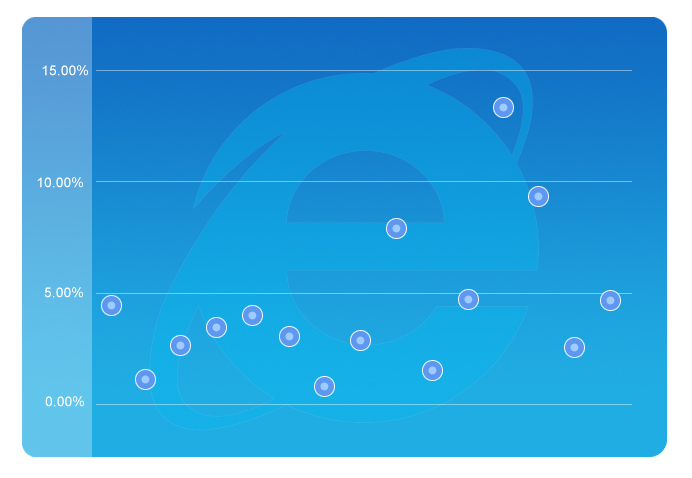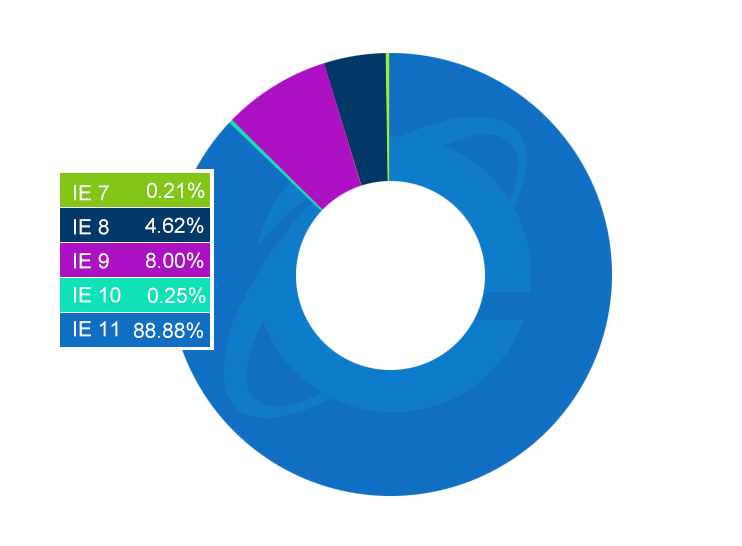Cockroaches are really hard to get rid of – they can live a week without their head. Internet Explorer has similar survival skills. Even though the most recent version of IE was released in 2013, Internet Explorer’s browser share has remained high enough that it can’t be dismissed out of hand.
While nearly all consumer users have moved on to Chrome and Safari, the IT departments at many large companies require their staff to use Internet Explorer. The reason for this is to avoid paying off technical debt. Companies have built business-critical tools specifically for older versions of IE. Moving off these systems is expensive and time consuming. So as a stop gap, IT teams make Internet Explorer the default browser for all employees.
This situation has caused major headaches for companies like ours who build websites for a living. Making a site that uses modern development techniques work in Internet Explorer is painful and time consuming. This is particularly true of older versions such as IE 8.
At the beginning of this year I took a fresh look at our Internet Explorer support policies. What follows is an analysis of IE usage in aggregate for fifteen of the sites we manage and our thinking on whether IE support is still necessary.
Depending on which stats you look at, Internet Explorer usage share is somewhere between 2% and 4% across the Internet. While this big picture number is useful, in my experience IE usage tends to vary widely from site-to-site, so we wanted to look at the data for our actual customers. We analyzed Internet Explorer usage for fifteen websites we manage on behalf of our clients. Being a DC-based firm, our clients tend to be nonprofits, trade associations, and advocacy groups.
Over the last 30 days, 2.18% of visitors to the sites we analyzed were from IE users. The median usage of Internet Explorer was higher: 3.18%.
Twelve of the fifteen sites we looked at had Internet Explorer usage under 5%. However three sites had usage percentages over 7.5% and one site saw 13.33% of usage coming from Internet Explorer. This scatter chart shows the dispersement.

The target audience of the site had a huge impact on the amount of IE usage. All of the sites with usage over 7.5% are focused fairly narrowly on reaching a corporate audience. Simply put, a lot of the people accessing these sites work at companies where IE is still the default browser.
There is some really good news in our data however, While we are still seeing people using IE, nearly 89% of IE users are running the last version of the browser: IE 11. Usage from other versions of IE was statistically insignificant.

This is important. While Internet Explorer 11 is not great, it is a lot easier to work with than older IE versions.
When making a decision, obviously the first step should be to look at the usage rate for your site specifically. Since IE usage can vary widely from site-to-site, you want to understand if your website is attracting a disproportionate amount of traffic from IE users. This data should inform your decision.
With that caveat, our default stance at Brick Factory for new projects will be to continue to support and test in Internet Explorer 11 since usage is persisting. Supporting IE 11 is not that time consuming, and 2-4% is still a fairly significant usage rate.
However, given that 89% of Internet Explorer usage is from IE 11, we will drop support for all other IE versions for new projects. Given that usage rates are statistically insignificant, it just doesn’t make sense any longer to take the time to get sites to work in IE 8, 9, and 10.
While I wish we could drop IE support altogether and am hopeful we will be able to in the near future, this is still a significant step. I cannot tell you how much time we have spent (wasted?) over the years doing battle with IE 8.
Sign up today to have our latest posts delivered straight to your inbox.